Neck Arthritis
Updated:
(Also known as Neck Osteoarthritis, Cervical Degeneration, Spinal Degeneration, Cervical Spondylosis)
N.B. Although the term ‘neck osteoarthritis’ would most accurately describe the condition in this document, the term ‘neck arthritis’ will be used as it is more widely known.
What is neck arthritis?
Neck arthritis is a relatively common condition characterized by gradual wear and tear to the joints of the neck over time. It is usually seen in older patients (> 60 years of age) and may cause a variety of symptoms such as pain and stiffness in the neck.
The spine comprises of many bones known as vertebrae, each of which has a large hole in its centre (figure 1). Because these bones are situated on top of each other, their holes line up, forming the spinal canal. This canal provides protection and space for the spinal cord and nerves to travel from the brain to the rest of the body. Each vertebra connects with the vertebra above and below via two types of joints: the facet joints on either side of the spine and the disc centrally (figure 2). There are also small holes on each side of the spine known as intervertebral foramen (IV foramen). These are located between adjacent vertebrae and allow nerves to exit the spinal canal (figure 2).
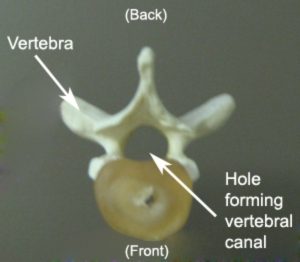
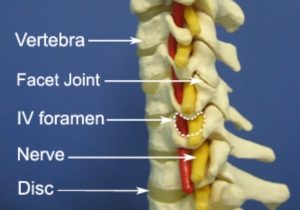
Over time, wear and tear to the discs, joints and bones can occur resulting in degenerative changes to the spine. These degenerative changes may include decreased disc height, loss of joint cartilage, bony spurring (osteophytes) and thickening of bone. This condition is known as neck arthritis (osteoarthritis). As the condition progresses the spinal canal and intervertebral foramen can begin to narrow and may eventually place pressure on the spinal cord and nerves resulting in a variety of symptoms.
Causes of neck arthritis
Neck arthritis is a condition that typically occurs over time due to gradual wear and tear associated with overuse or aging. It may be particularly common in patients with a history of neck pain or trauma to the spine or in those with lifestyles that have involved large amounts of lifting, slouching, bending or twisting of the neck or activities using the arms in front of the body.
Signs and symptoms of neck arthritis
This condition is usually seen in older patients. Many patients with minor neck arthritis may experience little or no symptoms. As the condition progresses patients may experience pain and stiffness in the neck and a reduced available range of neck movement. In more severe cases involving spinal cord or nerve compression, pain, pins and needles, weakness or numbness may be experienced in the neck, upper back, shoulders, arms or hands. Occasionally, headaches may also be present.
Patients with neck arthritis generally experience an increase in symptoms during activities that repetitively or continuously straighten or extend the neck (figure 3). Symptoms may also increase during end of range neck movements (such as turning the neck to one side fully), during lifting or with prolonged slouching (particularly when sitting). Symptoms tend to ease when lying down (in good posture) or upon applying warmth to the neck (such as during a warm shower).
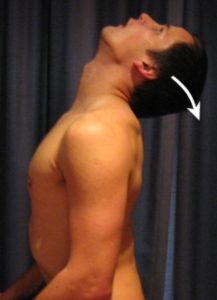
Diagnosis of neck arthritis
A thorough assessment from a physiotherapist combined with appropriate investigations is usually required to diagnose neck arthritis. An X-ray of the spine will typically demonstrate degenerative changes associated with the condition. Other investigations such as CT scans, bone scans or MRI’s may also be indicated to assess the severity and to determine the exact structures that are affected.
Treatment for neck arthritis

Members Only ContentBecome a PhysioAdvisor Member to gain full access to this exclusive content. For more details see Become a Member. Already a member? Login Now
Prognosis of neck arthritis
Although little can be done to reverse the degenerative changes to the spine associated with this condition, most patients can have a good outcome with appropriate management. Many patients with mild to moderate neck arthritis can often experience little or no symptoms with appropriate management and remain active with some lifestyle modifications. Patients with more severe degeneration can also demonstrate significant improvements with appropriate management, although typically, they may require more significant lifestyle modifications and often experience more severe symptoms and functional limitations.
Physiotherapy for neck arthritis
Physiotherapy treatment for patients with neck arthritis is important to assist with pain relief, improve flexibility and strength, and to ensure an optimal outcome. Treatment may comprise:
- soft tissue massage
- electrotherapy (e.g. ultrasound)
- mobilization
- traction
- dry needling
- postural correction
- use of a postural support
- use of postural taping
- ice or heat treatment
- education
- activity modification advice
- clinical Pilates
- hydrotherapy
- exercises to improve flexibility, strength, posture and core stability
Contributing factors to the development of neck arthritis
There are several factors that may contribute to the development of this condition. These factors need to be assessed and where possible, corrected with direction from a physiotherapist and may include:
- age (> 40 years)
- a lifestyle that has involved large amounts of lifting, slouching, arms forwards activities, bending or twisting
- history of injury or trauma to the neck (e.g. whiplash)
- excessive or inappropriate activity
- inadequate recovery periods from activity
- poor posture
- cervical spine stiffness
- poor core stability
- muscle weakness or tightness
- muscle imbalances
- inappropriate lifting technique
- biomechanical abnormalities
- genetics
Other intervention for neck arthritis
Despite appropriate physiotherapy management, some patients with neck arthritis continue to deteriorate. When this occurs, other intervention may be required. This may include pharmaceutical intervention, corticosteroid injection, the use of supplements such as fish oil, glucosamine and chondroitin, investigations such as an X-ray, CT scan, bone scan or MRI, or assessment from a specialist. The treating physiotherapist can advise on appropriate management and can refer to the appropriate medical authority if it is warranted clinically. In more severe cases of neck arthritis involving spinal canal stenosis or nerve compression, surgery may be required to relieve the pressure on the spinal cord or nerves.
Exercises for neck arthritis
The following exercises are commonly prescribed to patients with this condition. You should discuss the suitability of these exercises with your physiotherapist prior to beginning them. Generally, the initial and intermediate exercises should be performed 3 times daily, whilst the advanced exercises should be performed twice daily.
All exercises should only be performed provided they do not cause or increase symptoms. Your physiotherapist can advise when it is appropriate to begin the initial exercises and eventually progress to the intermediate and advanced exercises. As a general rule, addition of exercises or progression to more advanced exercises should only take place provided there is no increase in symptoms.
Initial Exercises
Chin Tucks
Begin sitting or standing tall with your back and neck straight, shoulders should be back slightly (figure 5). Tuck your chin in as far as you can go without pain and provided you feel no more than a mild to moderate stretch. Keep your eyes and nose facing forwards. Hold for 2 seconds and repeat 10 times provided the exercise is pain free. Repeat 3 times daily.
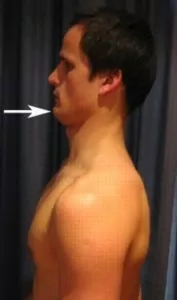
Shoulder Blade Squeezes
Begin sitting or standing tall with your back and neck straight (figure 6). Squeeze your shoulder blades together as far as you can go without pain and provided you feel no more than a mild to moderate stretch. Hold for 5 seconds and repeat 10 times provided the exercise is pain free. Repeat 3 times daily.
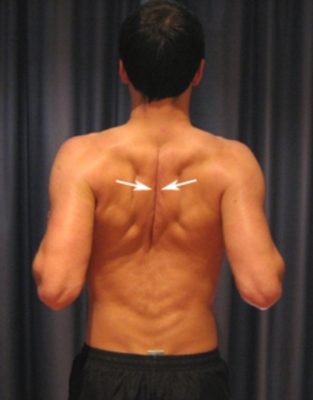
Neck Rotations
Begin sitting with your back and neck straight and your shoulders back slightly. Turn your head looking over one shoulder as far as you can go without pain and provided you feel no more than a mild to moderate stretch (figure 7). Then repeat the exercise turning your neck in the opposite direction. Keep your neck straight and don’t allow your head to poke forwards during the movement. Repeat 10 times to each side provided the exercise is pain free. Repeat 3 times daily.
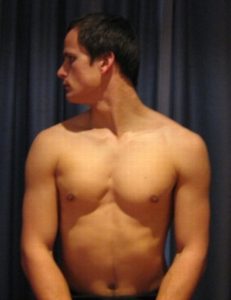
Intermediate Exercises

Members Only ContentBecome a PhysioAdvisor Member to gain full access to this exclusive content. For more details see Become a Member. Already a member? Login Now
Advanced Exercises

Members Only ContentBecome a PhysioAdvisor Member to gain full access to this exclusive content. For more details see Become a Member. Already a member? Login Now
Rehabilitation Protocol for neck arthritis

Members Only ContentBecome a PhysioAdvisor Member to gain full access to this exclusive content. For more details see Become a Member. Already a member? Login Now
 Physiotherapy products for neck arthritis
Physiotherapy products for neck arthritis
Some of the most commonly recommended products by physiotherapists to hasten healing and speed recovery in patients with this condition include:
-
 Wheat Bags
Wheat Bags -
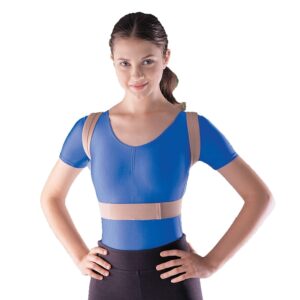 OPPO – Posture Aid / Clavicle Brace (OPP2075)
OPPO – Posture Aid / Clavicle Brace (OPP2075) -
 Premium Strapping Tape 38mm (Victor)
Premium Strapping Tape 38mm (Victor) -
 AllCare Pro-TENS Machine
AllCare Pro-TENS Machine -
 AllCare Tubing
AllCare Tubing -
 Fixomull Stretch 5cm x 10m
Fixomull Stretch 5cm x 10m -
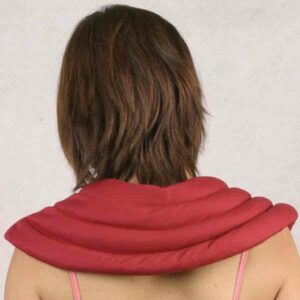 Therapack Hotpacks – Neck Warmer
Therapack Hotpacks – Neck Warmer -
 AllCare Instant Cold Pack (15 x 25cm)
AllCare Instant Cold Pack (15 x 25cm) -
 AllCare Foam Roller Round
AllCare Foam Roller Round -
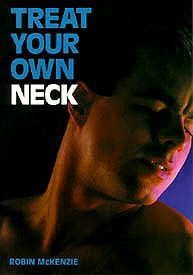 McKenzie Treat Your Own Neck Book
McKenzie Treat Your Own Neck Book -
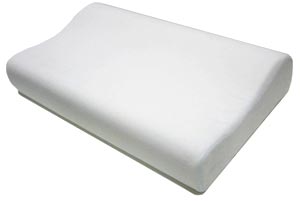 Dentons Impressions Classic Memory Foam Therapeutic Pillow
Dentons Impressions Classic Memory Foam Therapeutic Pillow
To purchase physiotherapy products for neck arthritis click on one of the above links or visit the PhysioAdvisor Shop.
 Find a Physio
Find a Physio
Find a physiotherapist in your local area who can treat this condition.
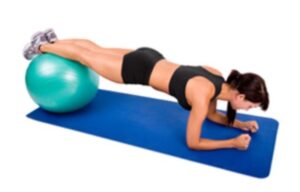 More Exercises
More Exercises
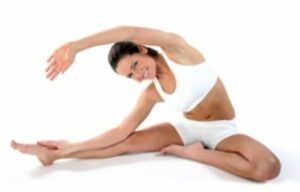 Recommended Reading
Recommended Reading
- Correct Posture
- Postural Taping
- Mobile Phone Ergonomics
- Ergonomic Computer Setup
- Ice or Heat
- Initial injury management and the R.I.C.E. Regime
- Return to Running following Injury
- Return to Sport following Injury
- Understanding Pain
- Neck Diagnosis Guide
Become a PhysioAdvisor Member

Link to this Page
If you would like to link to this article on your website, simply copy the code below and add it to your page:
<a href="https://physioadvisor.com.au/injuries/neck-head/neck-arthritis”>Neck Arthritis – PhysioAdvisor.com</a><br/>We offer detailed information on neck arthritis including causes, signs and symptoms, diagnosis, treatment, exercises and more.
Return to the top of Neck Arthritis.

